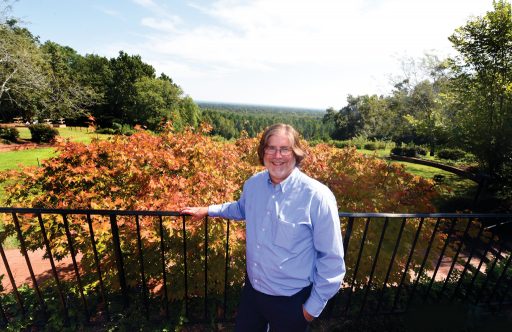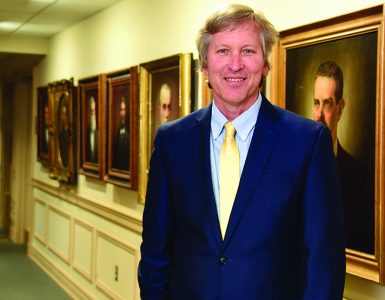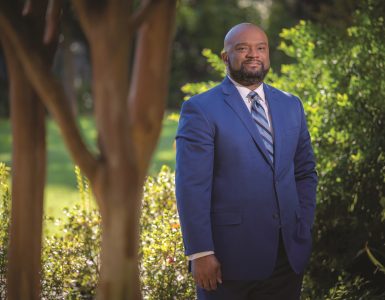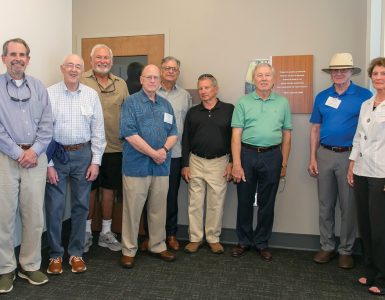One tiny vial, one day at a time.
Life was a buzz. He was working in a thriving anesthesiology practice in Jacksonville, Florida. He was physically fit and active, working long, hard days, then racing cars and driving fast boats. He was happily married to Kellie, whom he met while she was in nursing school and he was a student at the Medical College of Georgia. They had three beautiful girls and a house on the St. Johns River.
Then one day there was a tiny bit of the powerful synthetic opioid sufentanil left in a glass vial after a big surgical case.
We give opioids to patients every day. We see what they do,” says Dr. William Jacobs. He would ask patients how they felt after some big procedure and could not help but be amazed – and glad – that they felt great.
That day, he decided to see how the drug would make him feel.
The best feeling times thousands
Jacobs hesitates to use the obvious analogy, but it suffices to say it’s like the best feeling he has ever had multiplied by thousands.
He tried to quit more than 100 times, but the withdrawal would be so bad that as soon as someone put the drug back into his hand in the operating room, he would use. “Addiction by definition means you have lost control. ‘Just say no’ works for first use, misuse, abuse. Once somebody becomes addicted … their ability to say no is not there.”
Jacobs likes the analogy of a virus on your computer.
In the stone age of information technology, a virus was immediately catastrophic, crashing your system. Today,
it first runs subtly in the background. “My operating system thinks it is running fine. Maybe it runs a little slow, but I think it’s the internet or something. But that thing is stealing my password and my credit cards, and somebody is buying stuff off Amazon Prime. It’s not until it gets really bad that it crashes my computer.
“That is what happens in addiction. Your brain gets hijacked, and you are not running the show anymore. The disease is running the show.” The former A-student athlete certainly didn’t think it could run his. But for more than two years, it did.
In the tight-knit and often stressful confines of the operating room, his teammates noticed the changes in the affable young anesthesiologist. Dramatic mood swings would take him from on top of the world to being a jerk. When his partners of 10 years finally asked what was wrong, he lied. “That is what addicts do,” he says. He told them he wasn’t sleeping well, that there was trouble at home. Although they probably knew the truth as well, it was what they wanted to hear, he suspects. “Nobody wants to hear my partner is an addict.” He even offered to take a drug test.
In fact, at home, with the love of his life and his best friend, Kellie, he managed. He would secretly use before they went to bed. When withdrawal began to hit about 3 a.m., he would sneak out of bed and use a little more. He would arise at 5 a.m. to go back to the operating room and lie again. He would say he had a lot of big cases that day and needed a lot of sufentanil.
 Two weeks after the first confrontation, he was no better and probably worse. Two partners came to him again. “I just said: ‘Here’s the truth.’”
Two weeks after the first confrontation, he was no better and probably worse. Two partners came to him again. “I just said: ‘Here’s the truth.’”
Acknowledgement of physician impairment dates back nearly as long as 61-year-old Jacobs. The Federation of State Physician Health Programs Inc., which focuses on physician rehabilitation and monitoring for substance use disorders as well as other mental and physical illnesses, was founded in 1990, following the leadership of the American Medical Association and early state physician health programs, like the one that would help Jacobs in Florida. The Sunshine State was among the first to have a strong program that now enables a wide range of health care professionals who self-report an addiction disorder to keep their professional license and, ideally, their professional future, if all goes well. The state would later establish the nation’s first program for impaired medical students. The Georgia Professionals Health Program, which has a charter with the Georgia Composite Board of Medical Examiners, is one of the newest organizations, established in 2012 to help physicians, physician assistants and respiratory therapists, all licensed by the Georgia Board, with addictive disorders.
As with some other strong programs, the inaugural medical director of the Florida program, the late Dr. Roger A. Goetz, was a recovering addict. “It was great to have somebody who could relate. I knew I was out of control. I knew I was probably going to die if I kept going. It’s a wonder I did not die,” says the physician who believes that he did not only because he still had work to do.
With the help of the Florida program, he opted to seek recovery at the Farley Center in Williamsburg, Virginia.
The renowned 12 steps of recovery would become part of his permanent gait during three months of intense treatment at Farley. He began to realize that he could not go back to the operating room and to having vials of sufentanil put right into his hand. Jacobs said goodbye to his partners and a career he loved, and worried and wondered what was next.
He’d admittedly been making a lot of money; it was a day when private insurance payed more than Medicare. He wondered if he would lose his family. If not for them, he probably would have skipped town instead of going through three months of rehab anyway. Since his brain’s reward system was now rebooting to focus on the basics of food and shelter, he had to find a way to provide insurance for his family, assuming they stayed. So this MCG graduate – who trained in anesthesiology at the University of Alabama-Birmingham, where he received the Robert D. Dripps MD Award for Outstanding Resident – applied for a job at McDonald’s.
Lost and found
About that time, the somewhat lost soul heard about an addiction medicine meeting coming up in Jekyll Island from a recovering dentist at a 12-step meeting. A mostly smiling individual with just a snatch of a sarcastic nature, Jacobs wasn’t about to fall into the obvious trap that going through treatment prepares you to save the world. But the stars of the addiction field would be there and so was Jacobs’ future. People like Dr. Mark S. Gold, retired chair of the Department of Psychiatry at the University of Florida College of Medicine who now chairs RiverMend Health’s Scientific Advisory Boards. Gold founded UF medical school’s addiction program, which is one of the first in the nation; developed models to study the effects of cocaine, tobacco, opiates and food on the brain; and pioneered addiction treatment, including detoxification and withdrawal methods. Jacobs bravely sent an email to Gold and the now-deceased Dr. Conway Hunter, a fellow Georgia native, an obstetrician-gynecologist and recovering alcoholic who did help save the world, including helping ensure the first freestanding treatment center for addiction disorder in the Southeast, Peachford Hospital. At the meeting, Jacobs saw Gold alone for a moment and made a beeline. Jacobs said something, glanced down at his shoes, looked up and Gold was gone. Jacobs was about to make his exit when Dr. Scott Teitelbaum, Gold’s fellow, introduced himself at Gold’s request. Three days later, Teitelbaum approached Jacobs again, slapped his back and congratulated him on being the new “fellow.”
McDonald’s never called, but two weeks later, Jacobs started an addiction medicine fellowship at the University of Florida College of Medicine. He would stay in Gainesville for 17 years. Like Gold, his mentor and now friend, Jacobs would deftly walk the line between academic medicine and private industry to enable better services for those with addiction disorders and to train and inspire the next generation of addiction experts. “Patients got better medical care; facilities got the affiliation, and we got training sites,” Jacobs says.
Jacobs’ accomplishments there included serving as associate professor in addiction medicine and chief of interventional pain management at the university; founder and president of NexStep Integrated Pain Care Inc., a model program for the treatment of patients with both chronic pain and addiction disorders in Jacksonville, Florida; and medical director of the Smoking Cessation Clinic at Shands Hospital at UF Health. He served as medical director/chief medical officer at addiction treatment facilities such as Gateway Community and Rehabilitation Services in Jacksonville and the Stewart Marchman Center in Daytona Beach. He was founding medical director of Wekiva Springs in Jacksonville. He has served as an attending physician at the UF Health Vista West Dual Diagnosis Unit and the River Region Methadone Maintenance Program. Before coming back to Georgia, he was medical director of Lakeview Behavioral Health in Jacksonville.
Jacobs clearly thrived in his new profession, taking care of patients he absolutely understood. It was good timing certainly, as the long-held mantra of just giving patients more and more pain medication as their brains became tolerant to it meant an ever-increasing population needed help. The drug companies had responded by making progressively stronger drugs. Fentanyl, the parent drug of sufentanil, for example, was developed in 1960 and is 80 times more potent than morphine.
Sufentanil, which came out in the 1970s, is nearly 10 times as powerful as its parent and 500 times more powerful than morphine. Doctors were hearing that they should be kinder by treating chronic pain more aggressively. But at UAB where he trained in a multidisciplinary pain clinic, nobody was given a prescription to take a daily opioid. “Patients didn’t ask for it; we didn’t do it.”
But the paradigm had shifted. The number of opioid prescriptions written skyrocketed alongside the overdose rate. By 2011, prescription opioid deaths were more common than car wreck fatalities.
New opportunities at his alma mater
Gold would soon give his friend a heads up that RiverMend, a national leader in addiction treatment services, was looking at moving into Georgia and affiliating with the state’s public medical school. The physician, who admits to thriving in startups and chaos, came home to his alma mater in May 2014 as its first chief of addiction medicine. His still very intact family would soon follow.
These days, Jacobs stretches his long days between mornings at his medical school and its adult hospital, then late-mornings, takes the 17-mile drive to Bluff Plantation. The inpatient and outpatient facility was actually built years before as an executive retreat, and the beautiful, high ceilings and open concept reflect that heritage as, today, it provides an almost family-reunion setting, with natural gathering places, large dining tables, big porches and decks. In fact, Jacobs says he does some of his best work on the front porch. There are miles of walking trails and an exercise room that encourage physical fitness, which greatly supports mental fitness and recovery. They just built two more two-bedroom cottages for those whose treatment is best served by staying on site, and more expansion is planned for this year.
There’s also an intensive outpatient program with a sober living facility closer to town and a partial hospitalization program, intensive outpatient and structured living program in nearby Atlanta. Back in the beautiful woods of Augusta, there’s art and music therapy, a nursing station, a detoxification unit, a greenhouse. There are about a dozen recovery coaches, most of whom are recovering themselves, in keeping with the PEER support model pioneered by the MCG Department of Psychiatry and Health Behavior. There are MCG students and residents learning firsthand about this modern epidemic.
It’s a busy place.
“Addiction has moved into the mainstream,” Jacobs says.
This is drugs
Michael Jackson, Jamie Lee Curtis, Rush Limbaugh. If it seems that too many famous individuals – as well as the rest of us – are abusing drugs and alcohol, and many dying as a result, Jacobs says the next wave is still coming as still more powerful synthetic drugs emerge. Take cocaine. When the Spanish came to South America in 1492, they enslaved the natives and gave them coca leaves to chew so they could work longer digging emeralds and gold. However, addiction was not one of the resulting problems. But when coca leaves were ground to powder and snorted up the nose and/or injected into the veins it became addictive. Crack cocaine took it up another deadly notch.
The National Institute on Drug Abuse’s list of the most commonly abused drugs in America includes a cross section of plant-based ones like mescaline from the spineless peyote cactus, marijuana and tobacco as well as synthetic-makes like prescription opioids and sedatives. The institute reports that 18- to 25-year-olds are the biggest abusers of prescription opioids, ADHD stimulants and anti-anxiety drugs. Legal drugs, like beer, cigarettes and, increasingly, marijuana, often are gateways to reaching into someone else’s medicine cabinet for something even stronger. Jacobs’ gateways were social drinking and pot, which he started smoking back in high school. The false perception that a “prescription” drug is safer than a street drug further encourages use.
Prescription opioids are the most abused prescription drug, according to NIDA. An estimated 26.4 million to 36 million people worldwide abuse opioids; an estimated 2.1 million people in the United States had substance use disorders related to prescription opioids in 2012.
Overdose deaths in the United States from prescription pain relievers have more than quadrupled since 1999. The number of prescriptions written for these drugs also has skyrocketed from 76 million in 1991 to about 207 million in 2013. Stimulants and central nervous system depressants, like diazepam, are two other broad categories of prescription drugs with abuse problems. A 2014 presentation by Dr. Nora D. Volkow to the Senate Caucus on International Narcotics Control cited drastic increases in the number of prescriptions written, greater social acceptability for using medications and aggressive marketing by pharmaceutical companies as factors contributing to the severe prescription abuse problem.
One myth is that pain is protective of addiction to pain medicines. But patients in pain can get high from their medicine and addicted to it. Those, like Jacobs, who took it without the pain prompter, can just get higher.
A 2012 study by the University of Washington in Seattle said one in six surgeons has an alcohol-related problem; that 14 percent of male and 26 percent of female surgeons reported that they were abusing or dependent upon alcohol. Those researchers surveyed more than 25,000 and heard back from 7,000. Anesthesiologists like Jacobs make up about 5 percent of doctors and 15 percent of doctors in treatment. Familiarity is likely a factor; sensitization is likely another as they crack open glass ampules of opioids and some is inevitably aerosolized.
“You think addicts are living under the bridge prostituting for drugs. It’s an equal opportunity disease,” he says. The stereotyping is despite reports by groups like NIDA on the pervasiveness of the problems; for example, an estimated 5 million men and 4 million women reported prescription pain medicine misuse in the past year alone. It’s also despite the reality that programs for physicians with addiction disorders started nearly 30 years ago.
“Addiction is not about being weak-willed, morally bankrupt, crazy, dumb or stupid. It’s about having your brain hijacked,” Jacobs says, the succinct message he crafted rolling off his tongue.
As with many diseases, genetics can be a significant factor for up to 50 percent of patients, although Jacobs, for example, has no known family history of addiction to drugs or alcohol. But there is little question that some people’s brains simply – or actually complexly – respond to drugs differently.
Studies at the University of Florida College of Medicine and NIDA have illustrated it in brilliant colors.
Functional magnetic resonance images of cocaine addicts, for example, show how the reward center lights up when they take their drug of choice. When they look at videos of the show Nature, nothing happens until images of their drug of choice randomly surface and the lights come on again. “Even after nearly 20 years sober, you could put me in a scanner and show me an operating room with sufentanil and my brain would start lighting up like crazy,” Jacobs acknowledges.
Environment can be a factor, he says. He is not talking the home prices in your neighborhood, rather convenient access to after-school programs for children and physical activity for adults and children. Who you hang out with can be a factor in either direction, and initial drug use as well as environmental stress can produce genetic changes that increase addiction risk. So can major life stress, such as child abuse or domestic violence. Our permissive society, can also fuel the fire. Still, the first and subsequent drug uses are most often voluntary.
This is your brain on drugs*
While some may suspect that the difference between people who do and don’t have addiction problems is the amount or frequency of their exposure to whatever they are addicted to, the American Society of Addiction Medicine says it’s the way individuals respond to these exposures as well as stressors and environmental cues.
In reality, drugs and alcohol douse the reward circuitry of the brain with dopamine – the same circuitry that prompts us to seek survival basics of food, water, shelter and procreation. Patients become preoccupied with the drug or alcohol regardless of the ruin that accumulates in the path of use. This comes from impaired executive function, so individuals have problems with basics like perception, learning, impulse control, compulsivity and judgement. Still-developing adolescent brains are particularly vulnerable.
Brains can quickly become sensitized to the drug or alcohol so that the initial euphoria that results from acute activation of the reward centers of the brain is harder to achieve since the reward center never quite returns to baseline. In response, the brain stops making as much dopamine and/or neurons become less responsive to it. While it takes increasingly more substance to attain that high, patients don’t become tolerant to withdrawal, which leaves them anxious, agitated, dissatisfied and generally emotionally hyperresponsive. It also may make patients less likely to enjoy the more simple pleasures of life.
“If you are getting your natural rewards eating when you are hungry, drinking when you are thirsty, having sex, taking care of family and children, that is turning on your reward pathway, giving you pleasure and salience, making you feel good about what you are doing in your life.” Jacobs says. “Now, suddenly, you start taking something that is turning that on 1,000 times more. Those things are going to pale in comparison.”
Still, patients may continue to take the drug or alcohol even when they can no longer achieve a high. While not inevitable, relapse, even after significant periods of sobriety, is common. As with any chronic disease, the need for monitoring and diligence never ends.
As of August 28, 2016, Jacobs has been 19 years clean and sober.
This is Jacobs
Jacobs found his inspiration to be an anesthesiologist as a high school student working at Northeast Georgia Medical Center in his hometown of Gainesville, Georgia. He worked as an orderly and then with the respiratory therapy department. That second job often brought him to the trauma room at night and soon found him running errands for the anesthesiologists who were part of the trauma team. They took a liking to the young man, even taught him a few of the simpler tasks like starting an intravenous line. One of those natural educators was the late Dr. Calvin F. Allen Jr., MCG Class of 1953. Those early private lessons helped put Jacobs in great standing when it was time for clinical rotations in medical school. Jacobs, a 1981 MCG graduate, is chief of addiction medicine in the MCG Department of Psychiatry and Health Behavior, medical director of Bluff Plantation and chief medical officer of RiverMend Health Augusta and RiverMend Health Atlanta, intensive outpatient and partial hospitalization programs with outpatient detoxification available. He completed an anesthesiology residency at the University of Alabama at Birmingham in 1984 and postdoctoral training in addiction medicine at the University of Florida in 1999. He is program director of the new American Board of Addiction Medicine fellowship, which he started at his alma mater. Jacobs also is helping strengthen the addiction curriculum for medical students at MCG and across the nation as a member of Coalition on Physician Education in Substance Use Disorders LLC. Jacobs is triple board-certified in anesthesiology, pain medicine and addiction medicine. He has served as a consultant for the Florida Office of Drug Control, the United States Senate Crime and Drugs Subcommittee, and the U.S. Department of Labor. He has testified on Capitol Hill on MDMA, or ecstasy, and prescription misuse and abuse, and has testified and consulted for the Drug Enforcement Agency on safely prescribing narcotic drugs and model addiction treatment programs. He has been a monitoring physician for the Florida Board of Medicine and an evaluator and treatment provider for Florida Professionals Resource Network, Intervention Project for Nurses, and Lawyers Assistance programs. He has worked with the Duval County, Florida, Adult and Adolescent Drug Courts. He is a member of the Drug Free America Foundation Board of Directors.
Addiction and Public Health: A New Report
In mid-November 2016, U.S. Surgeon General Vivek Murthy released the first-ever surgeon general report to address substance misuse and related disorders, Facing Addiction in America: The Surgeon General’s Report on Alcohol, Drugs and Health. The report identifies substance use disorders as a public health problem that requires a public health solution. “It is time to change how we view addiction,” Murthy said in releasing his report. “Not as a moral failing but as a chronic illness that must be treated with skill, urgency and compassion. The way we address this crisis is a test for America.” He notes that nearly 21 million Americans – more than the number of people who have all cancers combined – suffer from substance use disorders, yet 90 percent of people with a disorder are not getting treatment. “That has to change,” Murthy said. Substance use disorder treatment in this country remains largely separate from the rest of health care, and stigma is one reason for the treatment gap, the surgeon general said. Recommended actions include eradicating negative attitudes and changing the way people think about substance use disorders; recognizing substance misuse and intervening early; and expanding access to treatment. For the full report, visit addiction.surgeongeneral.gov.









